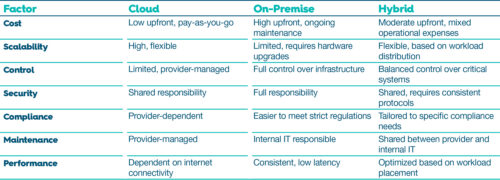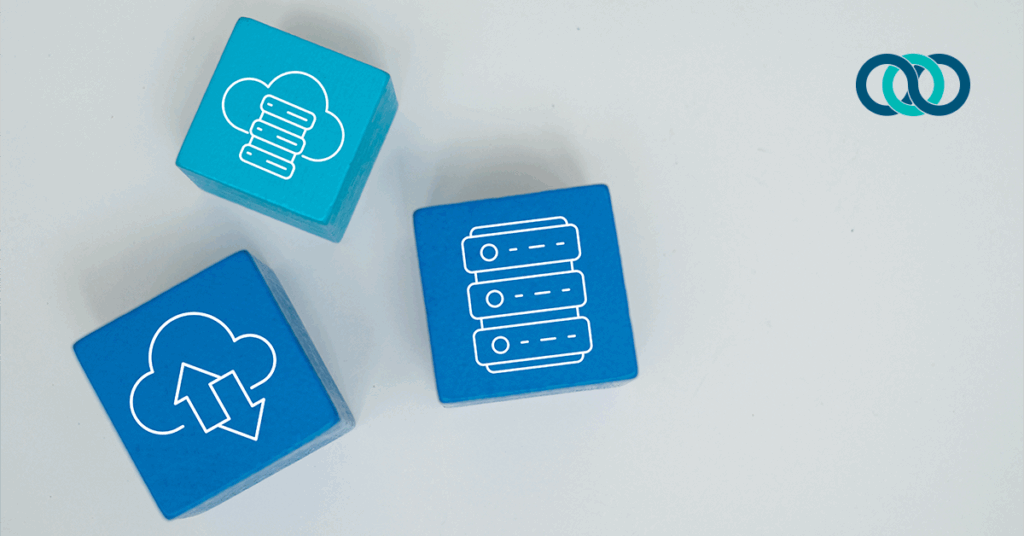What are the factors to consider when making a choice between Cloud, Hybrid, and On-Premise solutions? Do you need scalability, flexibility, or full control?
Infrastructure models involve evaluating various factors such as cost, scalability, security, compliance, and operational complexity.
Here’s a detailed comparison to help you make an informed decision for your company.
Cloud
Pros:
- Cost Efficiency: Minimal upfront investment with a pay-as-you-go model, leading to predictable expenses. Total Cost of Ownership (TCO) can be up to 77% lower than on-premise solutions.
- Scalability: Easily scale resources up or down to meet demand, accommodating fluctuating workloads.
- Accessibility: Global access to data and applications, supporting remote work and distributed teams.
- Maintenance: Cloud providers handle updates, maintenance, and infrastructure management, reducing the burden on internal IT teams.
- Disaster Recovery: Built-in redundancy and disaster recovery options minimize downtime and data loss risks.
Cons:
- Security and Compliance: The Shared responsibility model requires careful vendor evaluation to ensure data protection and compliance with regulations like GDPR and HIPAA.
- Vendor Lock-In: Proprietary platforms can make migrating to another provider complex and costly.
- Internet Dependence: Performance and access rely on stable internet connectivity; outages can disrupt services.
Cloud Infrastructure – Use Cases
- Startups & SaaS Platforms: Need to launch fast with low upfront costs and high scalability.
- Remote Workforces: Enables global access to applications and data.
- AI/ML Projects: Leverage cloud GPUs and scalable data storage for training models.
- Disaster Recovery Sites: Quick setup of backup environments in different regions.
On-Premise
Pros:
- Control: Complete control over data, hardware, and software configurations, allowing for tailored security measures and compliance adherence.
- Performance: Dedicated resources can offer consistent performance, especially for applications requiring low latency.
- Compliance: Easier to meet strict regulatory requirements by keeping data within the organization’s physical premises.
Cons:
- High Initial Costs: Significant upfront investment in hardware, software, and infrastructure, as well as ongoing maintenance expenses.
- Scalability Limitations: Scaling requires additional hardware purchases and manual configuration, making it less agile.
- Maintenance Overhead: Internal IT teams are responsible for all aspects of system maintenance, updates, and security.
On-Premise Infrastructure – Use Cases
- Defense Contractors: Require strict control and air-gapped networks for national security.
- Oil & Gas / Mining Operations: Remote areas with limited internet; need self-managed infrastructure.
- Enterprises with Legacy Systems: Existing investments in physical data centers are not easily cloud-migrated.
- Financial Trading Firms: Requires ultra-low latency and deterministic performance.
- R&D Labs: Run simulations or workloads that can’t risk external data exposure.
Hybrid
Pros:
- Flexibility: Combines the scalability of cloud with the control of on-premise systems, allowing for optimized workload distribution.
- Cost Optimization: Run non-critical tasks in the cloud while keeping sensitive data on-premise, balancing operational expenses.
- Enhanced Security and Compliance: Maintain control over critical data for compliance purposes while leveraging cloud capabilities for other operations.
Cons:
- Complexity: Managing and integrating two distinct environments requires specialized tools and expertise, increasing operational complexity.
- Security Risks: Data moving between environments can increase exposure to potential breaches; consistent security protocols are essential.
- Skill Gaps: IT teams may face challenges in managing hybrid infrastructures due to the need for expertise in both cloud and on-premise systems.
Hybrid Infrastructure – Use Cases
- Banks & Financial Services: Keep sensitive customer data on-prem for compliance; use the cloud for AI fraud detection.
- Healthcare Providers: Store patient records in-house while using the cloud for telemedicine or scheduling systems.
- Manufacturing: On-prem for low-latency machine control; cloud for analytics dashboards.
- Government Agencies: On-prem for classified data; cloud for public service portals or collaboration.
Summary Table:

Recommendations:
- Choose Cloud if your organization prioritizes scalability, remote accessibility, and reduced maintenance overhead.
- Opt for On-Premises if you require full control over your infrastructure, have strict compliance requirements, or need consistent performance for critical applications.
- Consider Hybrid if you seek a balance between control and flexibility, allowing you to optimize costs and performance while maintaining compliance for sensitive data.
TrainingPros can help you train your staff using any of these models.
TrainingPros is an award-winning training provider offering training on Avaya products and services for over twenty years. We employ highly skilled, versatile, expert trainers who are true professionals and experts on Avaya products and solutions.
We strive for excellence, and feedback from our students and instructors is key to our growth and success. Learner engagement and satisfaction are the most critical measures of the effectiveness of virtual training. TrainingPros surveys all our participants and evaluates feedback to drive continuous improvement in our training offerings. Our results on client satisfaction speak for themselves, with a 4.8 out of 5 customer satisfaction score. We employ many of the above virtual training best practices to bring our learners the best training experience possible. Visit us to enroll in an Avaya training class or contact us to schedule a custom class for your company today. Avaya.Training@TrainingPros.com
- 0share
- LinkedIn0
- Twitter0
- Facebook0
- Love This0












